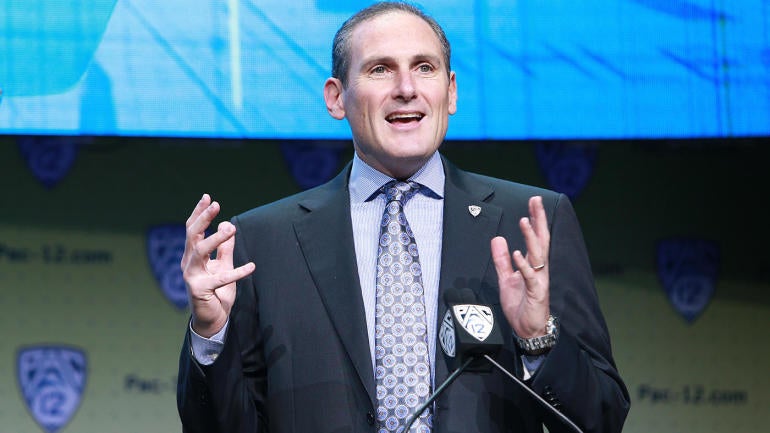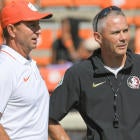
Amid the Pac-12's recent failings, the college landscape has almost become more of a Power Four. That's the best way to sum up the departure of Pac-12 commissioner Larry Scott. It's definitely the best way to describe how far Scott's league has fallen on his watch.
College sports' highest-paid commissioner had also become one of its biggest lightning rods, and in the end, one of its biggest underachievers. The league's CEOs indicated as much Wednesday night when they mutually agreed to part with the 56-year-old Scott.
Truth be told, they couldn't let Scott anywhere near negotiations of a new television rights deal that is looming. Too much is at stake. Too much had already been lost on Scott's watch.
"The conference is very well positioned for the next TV deal. A lot of changes are going on in college sports," Scott himself told CBS Sports on Wednesday night.
The Harvard-education former head of the Women's Tennis Association shook up college athletics a decade ago. A bold move to steal half the Big 12 fizzled, but adding Utah, Colorado and a conference network seemed to be enough.
College athletics was changing, and Scott was at the center of it pulling the levers. The Pac-12 got more money for its rights with Scott in command. The league had improved its spot among the top conferences in what was nicknamed the Power Five with the ACC, Big Ten, Big 12 and SEC.
But in terms of value -- both real and perceived -- there was slippage. A little at first, a lot as time went on -- financially, athletically and perceptibly.
Scott made the tactical mistake of signing a 12-year deal with ESPN and Fox that expires in 2024. That has allowed his peers to renew deals for bigger money within that lengthy time frame.
Once-proud Pac-12 basketball became known more for whatever wacky thing Bill Walton said the night before. In 2018, a Pac-12 team didn't reach the Round of 32 in the NCAA Tournament for the first time since 1986.
The Pac-12 has landed only two teams in the seven-year-old College Football Playoff, none in the last four years. It has been getting pounded in recruiting with its best players routinely heading South and East to the likes of Alabama and Clemson.
"There is no [recruiting] fence built around the Pac-12," one conference athletic director lamented.
Short of winning championships in revenue sports, the Pac-12 became a show. Media days were held on the floor of the Rose Bowl and Paramount Studios. The league played basketball games in China.
Scott became a show himself. On his watch, there was a massive football officiating fiasco. The league was caught essentially trying to buy coverage from the Los Angeles Times. After the Pac-12 moved its basketball tournament to Las Vegas, The Oregonian reported a resort casino comped Scott the use of a 3,400 square-foot suite.
A plan was launched to sell future shares in the conference, sort of like taking out a home equity loan on media rights. One problem: If it worked, part of that money would already be spent when the rights actually were renewed.
The Pac-12 Network was the only enterprise of its size in college sports without a network partner. Its underperformance was glaring. Scott could never land a deal with cable giant DirecTV. Scores of Pac-12 fans couldn't see their teams even in their own cities. In 2015, the network was available in 90 million homes, but only 15 million subscribers signed up.
"I think that ended up being the start of his downfall," one source within the Pac-12 said. "There was really a deep dig in and arrogance there just really pushed the envelope rather than get a [DirecTV] deal done."
"We don't need someone learning on the job," another Pac-12 AD concluded.
That was a reference to Scott never having college experience before taking over the conference. From the beginning, he was a non-traditional hire. A tennis executive was suddenly in charge of West Coast football futures. There is something to be said having walked across a college campus as an administrator. Scott never had in his position of power.
Scott is likeable enough, but the staff still talks about an urgent all-hands-on-deck meeting one year. Was Scott going to announce he'd finally struck a deal with DirecTV? Nope. He announced his own new contract. How's that for staff morale?
Scott's management style was an easy target. At the same time, he was in charge of laying off scores of Pac-12 employees amid the COVID-19 pandemic while making $5.3 million per year, the most among his peers. That total is more than the SEC and Big Ten commissioners earned in 2020, combined. Scott moved the conference office from bucolic Walnut Creek, California, to downtown San Francisco where rent cost $7 million per year.
For that money, the Pac-12 had fallen far behind those conferences in earning power. The Pac-12 schools currently cash network rights checks worth $32 million. Big Ten schools lead the country getting $54 million per year.
Writing about commissioners isn't necessarily a sexy subject. But when they change, it opens up speculation. News happens. There was already rumors that the Pac-12's weakened stance had left it open to poaching, perhaps with Arizona and Arizona State heading the Big 12.
By June 30, when Scott leaves, the Big 12's Bob Bowlsby will be the only remaining Power Five commissioner who built, implemented and approved the CFP in 2012.
Pac-12 presidents will undoubtedly be looking for a conference AD to replace Scott. Look for these names to come up that would unite the league: Bernard Muir (Stanford), Ray Anderson (Arizona State) and Rick George (Colorado). Others in contention: Mike Aresco (AAC commissioner), Condoleezza Rice (former Secretary of State and Stanford provost) and Jamey Zaninovich (Pac-12 deputy AD).
Asked how Scott's tenure with the Pac-12 will be remembered, he said, "I don't know. That's for others to say."
"Larry's failing was that he didn't see the value in relationships," said a Pac-12 AD, calling Scott's tenure a series of "failed strategies."
Asked about Scott's legacy, another source sighed heavily. "Complicated. You could argue that, with the group of presidents that hired him, he did what they wanted him to do," that source said.
Scott increased revenue and convinced the schools to share it equally. He started that network, for better or worse. Scott also watched the rest of the Power Five lap his league.
The Pac-12 is still one of the five major conferences because the networks will always pay big money for the West Coast markets.
But in terms of what matters on the field, those revenue-fueled championships, the Pac-12 is now watching a Power Four move on without it.





















